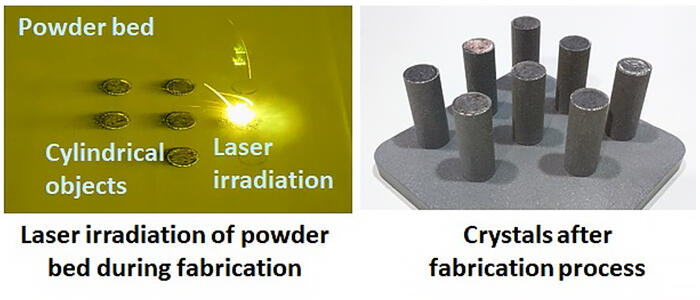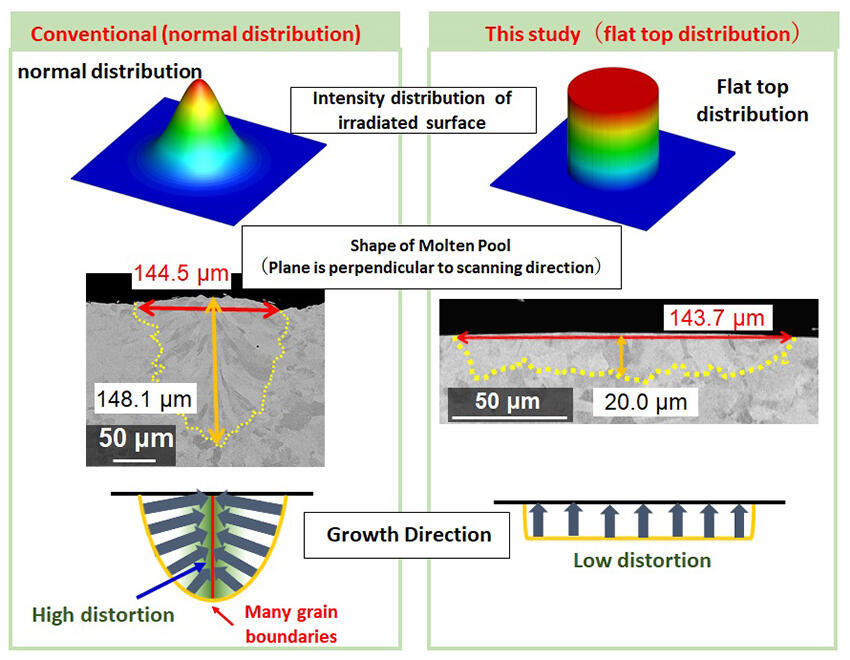A research team led by Dr. Dennis Edgard Jodi, a junior researcher (graduate student at Kyushu University), Senior Researcher Dr. Tomonori Kitajima (associate professor at Kyushu University), and Dr. Makoto Watanabe, all of the National Institute for Materials Science, and Professors Takayoshi Nakano and Yuichiro Koizumi of the Graduate School of Engineering at Osaka University, has successfully formed a single crystal with few defects and uniform crystal orientation by irradiating nickel powder with a laser with a large beam radius (flat top) and uniform intensity distribution. The use of laser 3D printers is expected to greatly expand the range of parts that can be manufactured using single crystals, opening up applications not only for heat-resistant materials used in aircraft engines and gas turbines, but also for a variety of other single crystal materials. The team's findings were published in Additive Manufacturing Letters.


Provided by NIMS
In the electron beam method that has been reported for single crystal fabrication, the necessary equipment is expensive, requires a high vacuum and has high operating costs, which has resulted in a lack of uptake of the equipment. On the other hand, in less expensive laser-based equipment, it is difficult to control the direction of crystal growth at the solid-liquid interface in a single direction because the intensity distribution of the laser beam irradiated surface follows a normal distribution, and introduces crystal defects caused by large strain during solidification. The resulting crystals are polycrystalline bodies composed of crystals in different orientations, and the presence of many grain boundaries (interfaces between crystal grains) has been a problem.
The research team has developed a technique in a laser-based fabrication system for forming single crystals from metal powder without using seed crystals. In this case, they used pure nickel powder, which does not undergo any change in crystal structure during the process from high to low temperatures after solidification.
The key to the development of the new technology was the application of a laser beam with a flat intensity distribution. The laser-based fabrication system uses a laser beam with a large diameter and flat intensity distribution to irradiate a nickel powder bed, and the shape of the melt pool formed when the powder melts is controlled to be planar by optimizing the fabrication conditions.
This controlled the direction of crystal growth during solidification to one direction nearly parallel to the beam irradiation direction. The fabricated body produced in these developments is a cylinder with a diameter of 12 mm and a height of 30 mm. In the conventional normal distribution of the irradiation surface intensity distribution, the solid-liquid interface is convex toward the melt pool, and crystals growing during solidification collide at the center, forming a planar defect called a grain boundary there. At the same time, large thermal contraction strain occurs near that interface during cooling. However, with a laser with a flat intensity distribution, crystals grow in the beam direction from the planar solid-liquid interface during solidification. In doing so, crystals solidified in the previous layer during fabrication act as seed crystals, and crystals with a preferential orientation in the growth direction are gradually selected for growth. This thermal contraction strain during solidification is controlled compared to normally distributed laser irradiation. Thus, the orientation of the growing crystals is aligned in one direction, and the density of linear and planar defects introduced by grain boundaries and strain, which are formed when crystals collide during solidification, can be kept low, resulting in single crystals.
The results of the team's work can be applied to the fabrication of single crystals in other metals and alloys. In particular, the shapes of aircraft engines and gas turbines components are becoming more complex and lighter, and demand is increasing for the additive manufacturing of nickel-based superalloys, which are heat-resistant materials. The practical application of fabricating single-crystals, which have superior high-temperature strength compared to polycrystals, is expected to accelerate global research and development if it becomes possible to use the laser method, which is inexpensive and broadly used.
Journal Information
Publication: Additive Manufacturing Letters
Title: Manufacturing single crystals of pure nickel via selective laser melting with a flat-top laser beam
DOI: 10.1016/j.addlet.2022.100066
This article has been translated by JST with permission from The Science News Ltd.(https://sci-news.co.jp/). Unauthorized reproduction of the article and photographs is prohibited.




